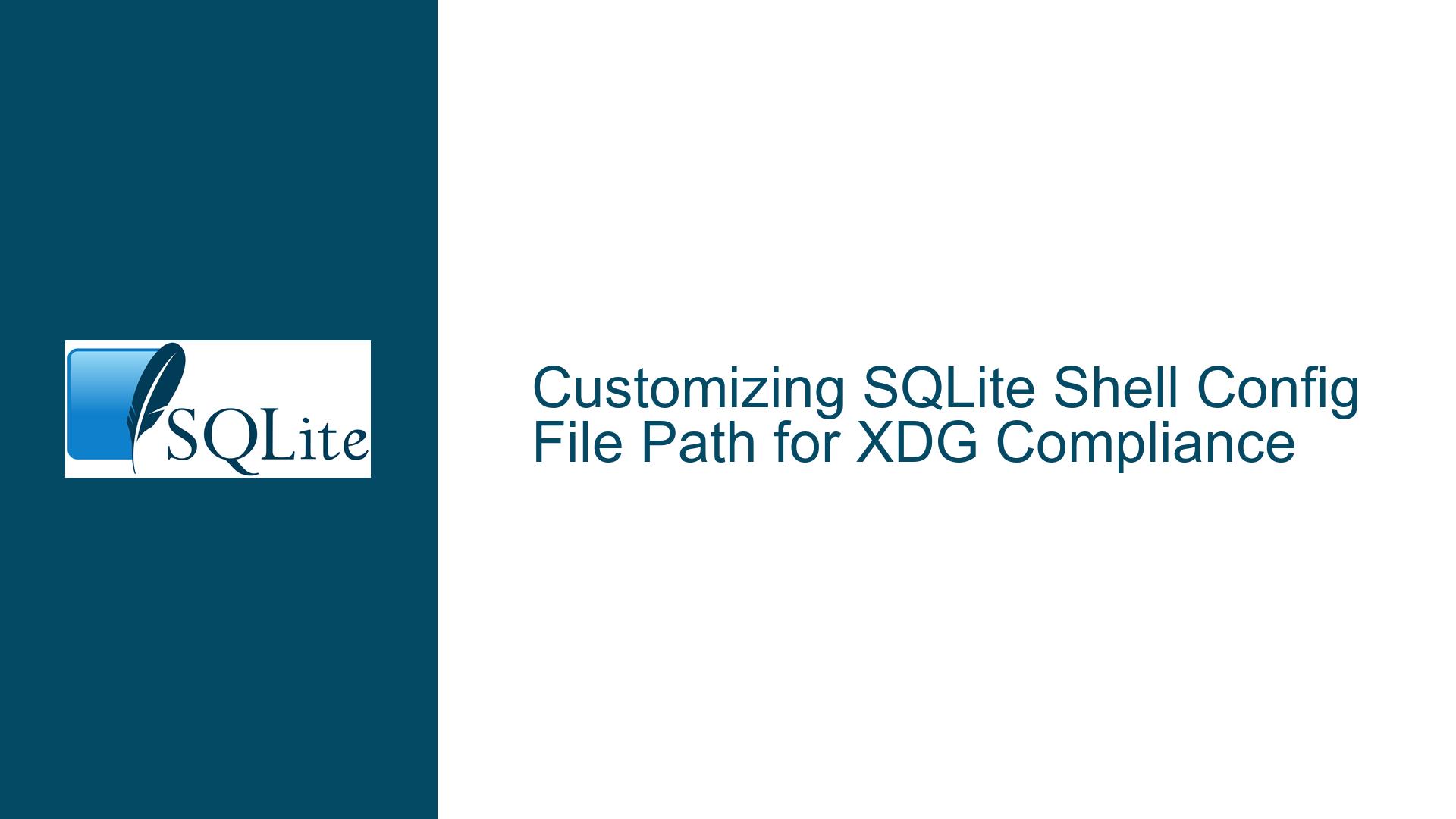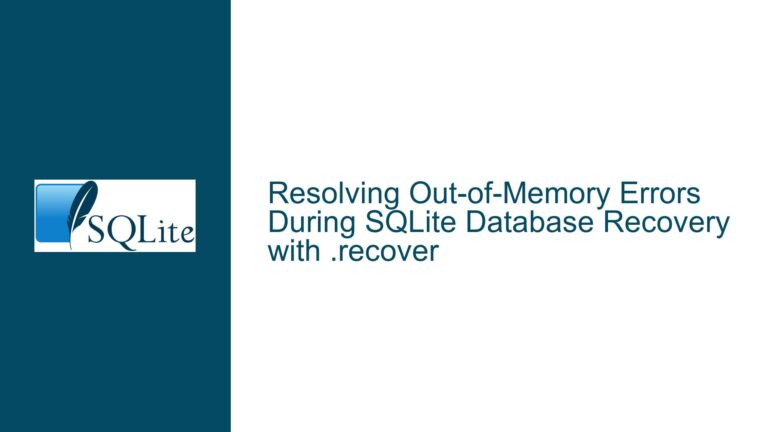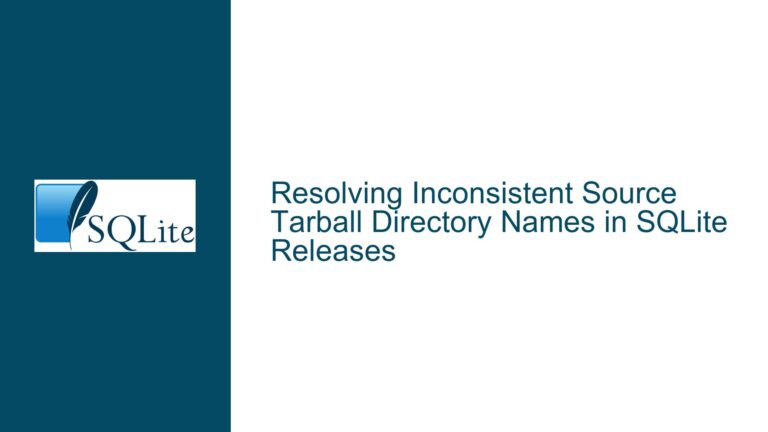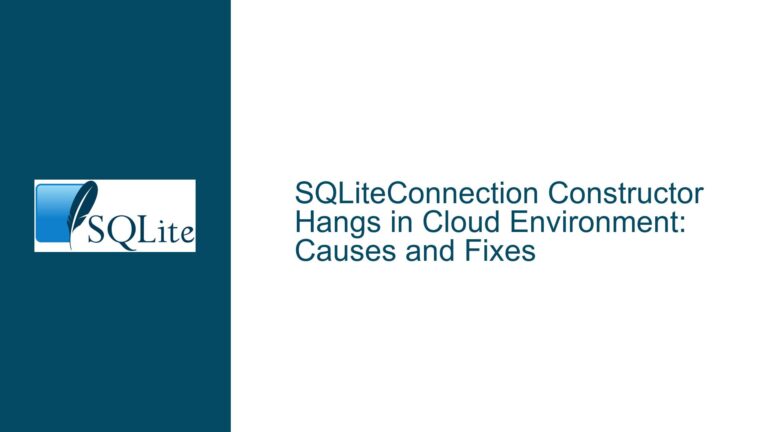Customizing SQLite Shell Config File Path for XDG Compliance
Understanding the Need for XDG Base Directory Specification Compliance in SQLite
The XDG Base Directory Specification is a set of guidelines that standardizes where user-specific configuration files, data files, and cache files should be stored in a Linux environment. This specification aims to reduce clutter in the user’s home directory by organizing files into specific directories under ~/.config, ~/.local, and ~/.cache. Many modern applications adhere to this specification to maintain a clean and organized home directory.
In the context of SQLite, the default behavior is to look for the user-specific configuration file, .sqliterc, directly in the user’s home directory (~/.sqliterc). However, this approach does not align with the XDG Base Directory Specification, which recommends storing configuration files in ~/.config. The discussion revolves around the need to modify SQLite’s behavior to read the configuration file from a more standardized location, such as ~/.config/sqlite/.sqliterc or ~/.config/sqlite3/sqliterc.
The primary issue here is that SQLite does not natively support reading the configuration file from an XDG-compliant directory. This limitation forces users to either stick with the non-compliant default location or use workarounds to achieve the desired behavior. The discussion explores potential solutions, including the use of wrapper scripts and the possibility of future updates to SQLite that would natively support XDG-compliant paths.
Exploring the Implications of Non-Standard Configuration File Paths
The default behavior of SQLite, which places the .sqliterc file directly in the user’s home directory, has several implications. First, it contributes to the clutter in the home directory, which can become overwhelming as more applications store their configuration files there. This is particularly problematic for users who prefer to maintain a clean and organized home directory, as recommended by the XDG Base Directory Specification.
Second, the non-standard location of the .sqliterc file can lead to confusion for users who are accustomed to the XDG-compliant directory structure. They may expect to find SQLite’s configuration file in ~/.config/sqlite/ or a similar directory, and the presence of .sqliterc in the home directory can be inconsistent with their expectations.
Third, the lack of XDG compliance in SQLite’s configuration file path can complicate the management of configuration files across different systems. Users who work on multiple machines or who use version control systems to manage their dotfiles may find it challenging to maintain consistency when some applications adhere to the XDG specification while others do not.
The discussion highlights the need for a solution that allows SQLite to read its configuration file from an XDG-compliant directory, thereby addressing these issues and aligning SQLite with the broader ecosystem of Linux applications.
Implementing a Wrapper Script as a Temporary Workaround
Given that SQLite does not natively support reading the configuration file from an XDG-compliant directory, one of the proposed solutions is to use a wrapper script. A wrapper script is a shell script that invokes the SQLite binary with specific options or arguments, effectively modifying its behavior without changing the binary itself.
In this case, the wrapper script would invoke the SQLite binary (sqlite3) with the -init option, which specifies the path to the configuration file. By pointing the -init option to the desired XDG-compliant path (e.g., ~/.config/sqlite/.sqliterc), the wrapper script can effectively make SQLite read its configuration from the correct location.
The wrapper script could be placed in a directory that is included in the user’s PATH, such as ~/bin or ~/.local/bin. This allows the user to invoke SQLite as usual, with the wrapper script transparently handling the redirection of the configuration file path. For example, a wrapper script named sqlite3 in ~/bin could contain the following:
#!/bin/bash
exec /usr/bin/sqlite3 -init ~/.config/sqlite/.sqliterc "$@"
This script would execute the actual SQLite binary (/usr/bin/sqlite3) with the -init option set to the XDG-compliant path, followed by any additional arguments passed to the script. The exec command ensures that the script replaces itself with the SQLite process, preserving the behavior of the original command.
While this workaround is effective, it is not an ideal long-term solution. It requires users to create and maintain wrapper scripts, which can be cumbersome, especially when dealing with multiple systems or when the SQLite binary is updated. Additionally, the wrapper script approach does not address the root issue, which is the lack of native support for XDG-compliant paths in SQLite.
Considering the Future: Native Support for XDG-Compliant Paths in SQLite
The discussion also touches on the possibility of future updates to SQLite that would natively support reading the configuration file from an XDG-compliant directory. This would eliminate the need for wrapper scripts and provide a more seamless experience for users who prefer to adhere to the XDG Base Directory Specification.
One of the key considerations in implementing native support for XDG-compliant paths is determining the exact location of the configuration file. The discussion suggests two potential paths: ~/.config/sqlite/.sqliterc and ~/.config/sqlite3/sqliterc. The latter option, which uses sqlite3 instead of sqlite in the directory name, is favored because it aligns with the name of the SQLite CLI binary (sqlite3).
The use of sqlite3 in the directory name is more consistent with the naming conventions of other applications that follow the XDG specification. For example, many applications use the name of their binary as the directory name under ~/.config. This consistency makes it easier for users to locate configuration files and reduces the likelihood of confusion.
Another consideration is whether to include the dot (.) in the filename. The current configuration file is named .sqliterc, but the discussion suggests that the dot may be superfluous in the context of an XDG-compliant directory. The proposed filename is sqliterc, which is simpler and more consistent with the naming conventions of other configuration files in ~/.config.
Implementing native support for XDG-compliant paths in SQLite would require changes to the SQLite source code. Specifically, the SQLite shell (sqlite3) would need to be modified to check for the configuration file in the XDG-compliant directory before falling back to the default location (~/.sqliterc). This change would ensure backward compatibility while providing a more standardized experience for users who prefer to follow the XDG specification.
Best Practices for Managing SQLite Configuration Files in an XDG-Compliant Environment
For users who wish to manage their SQLite configuration files in an XDG-compliant environment, there are several best practices to consider. First, it is important to decide on a consistent location for the configuration file. As discussed, ~/.config/sqlite3/sqliterc is a logical choice that aligns with the XDG specification and the naming conventions of other applications.
Second, users should consider using a wrapper script as a temporary workaround until native support for XDG-compliant paths is implemented in SQLite. The wrapper script should be placed in a directory that is included in the user’s PATH, such as ~/bin or ~/.local/bin, and should invoke the SQLite binary with the -init option pointing to the desired configuration file path.
Third, users should be aware of the potential impact of updates to the SQLite binary. If the SQLite binary is updated, the wrapper script may need to be updated as well to ensure that it continues to point to the correct binary. This is particularly important for users who manage multiple systems or who use package managers to update their software.
Finally, users should consider contributing to the SQLite project by submitting feature requests or patches that add native support for XDG-compliant paths. This would help ensure that SQLite continues to evolve in a way that meets the needs of its users and aligns with modern standards for configuration file management.
Conclusion: Moving Towards a More Standardized SQLite Configuration Experience
The discussion around customizing the SQLite shell configuration file path highlights the importance of adhering to modern standards like the XDG Base Directory Specification. While SQLite currently does not natively support reading the configuration file from an XDG-compliant directory, there are workarounds available, such as using a wrapper script. However, these workarounds are not ideal and can lead to additional complexity in managing configuration files.
The future of SQLite configuration management lies in the implementation of native support for XDG-compliant paths. This would provide a more seamless and standardized experience for users, reducing clutter in the home directory and aligning SQLite with the broader ecosystem of Linux applications. By adopting best practices and contributing to the SQLite project, users can help drive this evolution and ensure that SQLite remains a powerful and user-friendly tool for database management.






